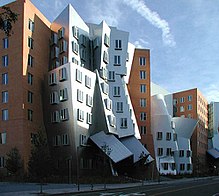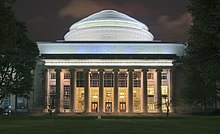Massachusetts Institute of Technology
![]()
MIT is a redirect to this article. For other meanings, see MIT (disambiguation).
The Massachusetts Institute of Technology (MIT) is a technical college and university in Cambridge in the US state of Massachusetts. It is considered one of the world's leading top universities. The university is located on the Charles River in Cambridge, directly across from Boston and downstream from Harvard University. Founded in 1861, MIT is a private, non-sectarian technical university that was the first to train chemical engineers and incorporate economics, social sciences, and humanities into engineering education. Currently, MIT has over 10,000 students.
MIT boasts a high level of education, with students involved in research activities from an early age. It consistently achieves top rankings in international comparisons. The university is a member of the Association of American Universities, an association of leading research-intensive North American universities that has existed since 1900.
A network of high-tech small businesses has grown up around MIT: In the late 1990s, venture capital was abundant, so many students' preferred career choice was to start a high-tech startup.
The university is also the founding organization and headquarters of the World Wide Web Consortium (W3C), the standards body for the World Wide Web. Since 2002, MIT has successively made all of its course materials publicly accessible via the Internet, thus supporting OpenCourseWare. In the MIT OpenCourseWare project alone, almost 2000 courses in 33 subjects have been made available in this way.
History
Modeled after German- and French-speaking polytechnics, MIT was founded on April 10, 1861, as a tripartite institution consisting of "a society of arts, a museum of arts [industrial arts], and a school of industrial science." Founder William Barton Rogers, a noted naturalist, wanted to create an independent university with a focus on the needs of an increasingly industrialized America. Because of the Civil War, the first students could not be admitted until 1865. In the years that followed, MIT gained a first-class reputation.
Because of the persistent funding shortfalls, a merger with neighboring Harvard University was planned around 1900. However, this could not be implemented due to massive protests by former MIT students. In 1916, the campus was moved from Boston to Cambridge on the opposite bank of the river.
MIT's reputation continued to rise after World War II, during which it contributed to the development of radar technology. The arms race and space travel during the Cold War created a government-sponsored demand for high technology. MIT also became known for the Whirlwind digital computer, which was developed and built there from 1944 to 1952 under the direction of computer pioneer Jay Wright Forrester.
Other developments from MIT's postwar laboratories included the ferrite core memory and the Apollo program's automatic spacecraft control system. Since the advent of the personal computer, MIT has also occupied a central role in the key technologies of the information age.
In 2001, MIT President Charles Marstiller Vest stated that MIT as an institution had discriminately hindered the careers of female faculty members and researchers. He announced organizational steps toward gender equality. On December 6, 2004, Susan Hockfield, a scientist in the field of molecular neurobiochemistry, became the first female president to take office after 15 male presidents. In July 2012, Leo Rafael Reif followed her in office.
On April 18, 2013, a campus police officer was shot and killed outside the Stata Center by Tamerlan and Dzhokhar Tsarnaev, who had carried out the Boston Marathon bombing three days earlier.
The inner main belt asteroid (2460) Mitlincoln was named after the Massachusetts Institute of Technology and Lincoln NearEarth Asteroid Research.

Stata Center

The Rogers Building, ca. 1901
Organization
Campus
The MIT campus is located in Cambridge, not far from Harvard University, directly on the Charles River with a view of the Boston skyline. At the eastern end, it borders the Longfellow Bridge, which leads to Boston.
From the founding years of MIT, the "Maclaurin Buildings" should be mentioned, which form the entrance area to the campus. They were designed by Welles Bosworth in the neoclassical style of the time. They were completed in 1916 and are characterized by the generous lighting and especially the central dome.
The friezes bear the names of great natural scientists, for example Aristotle, Isaac Newton, Benjamin Franklin, Louis Pasteur, Antoine Lavoisier, Michael Faraday, Archimedes, Leonardo da Vinci, Charles Darwin and Nicolaus Copernicus, each surrounded by groups of names of matching researchers who contributed to the respective field of research of the "greats".
Lavoisier, for example, is in the circle of Boyle , Cavendish , Priestley , Dalton , Gay-Lussac , Berzelius , Woehler , Liebig , Bunsen , Mendeleev , Perkin and van't Hoff .
Later buildings from 1950 to 1970, on the other hand, lack charisma, even though some of them were designed by MIT alumnus I. M. Pei, such as the Green Building (the main building of the Department of Earth, Atmospheric, and Planetary Physics), the Institute of Chemical Engineering, the tallest building on campus, and the Wiesner Building, which houses the MIT Media Lab.
An extensive recent building program included the "Stata Center," designed by Frank Gehry and completed in 2004; the Simmons Hall residence hall, designed by Steven Holl; the Zeisiger Sports Center; and a new building, designed by Charles Correa, for the Picower Center for Learning and Memory, the Institute for Brain and Cognitive Science, and the McGovern Institute for Brain Research.
In 1998, the "Stata Center" had to make way for an old building that had been erected as a provisional structure during the Second World War. Actually, it should have been demolished six months after the end of the war at the latest, but despite its ugliness it proved to be a hotbed of creative projects for many years.
Some of the newest and architecturally interesting buildings include:
- Baker House, designed by Alvar Aalto
- Kresge Auditorium, designed by Eero Saarinen
- Wiesner Building, designed by I. M. Pei, with the tiled exterior designed by Kenneth Noland.
Teaching
MIT has five faculties, called Schools:
- School of Architecture and Planning (Architecture and Spatial Planning)
- School of Engineering (Engineering)
- School of Humanities, Arts, and Social Sciences
- Sloan School of Management (Management and Economics)
- School of Science (Natural Sciences)
The learning load at MIT is very heavy in the lower semesters. Nevertheless, the rate of successful course completion is high. This is explained by the anti-authoritarian culture and the paradigm that acquired knowledge must be shared. In practice, this means that older students and professors are helpful to the younger ones.
Written examinations take place regularly during the semester. These examinations are less about concrete knowledge and more about the students' ability to solve complex problems. Thus, there are hardly any multiple-choice tests, the work results are to be formulated freely. The analysis and correction of these tests is correspondingly more time-consuming.
There will also be practical tasks to solve. Students are given a design task and compete for the best design to solve it.
Within the framework of the Undergrade Research Opportunities Program (UROP), already low semesters are integrated into the research activities of their institute. Most of the practical work takes place on Friday afternoons and weekends when normal teaching is not in session.
Since 2007, lectures have also been transmitted via the Internet.
Study offer
In addition to its focus on science and technology, MIT also has departments of philosophy, economics, business administration, linguistics, and anthropology.
- Architecture and planning
- Humanities, Arts and Social Sciences
- Health Sciences and Technology (Whitaker College of Health Sciences and Technology).
- Engineering
- Science
- Economics (including the Alfred P. Sloan School of Management)

Facade details of Simmons Hall

Simmons Hall (residence hall for all first-year students, completed in 2003)

Dome building from 1916
Search within the encyclopedia